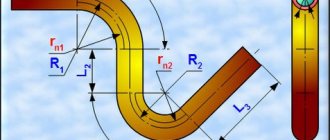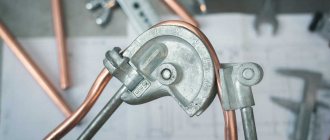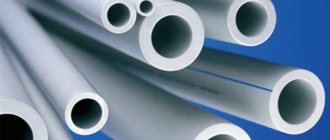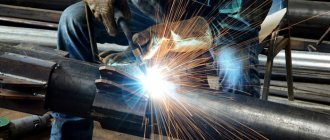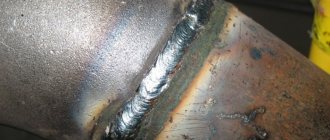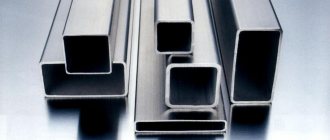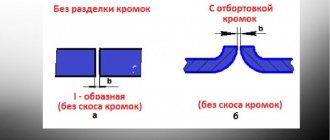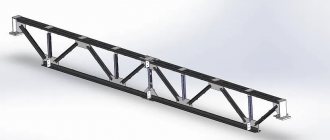In factories and large enterprises, it is necessary to lay, without exaggeration, kilometers of pipelines. And it is advisable to install these pipes as efficiently as possible, minimizing the likelihood of breakthroughs, the formation of dangerous areas, etc.
As you know, the safest section of pipe is the section that is not fastened with fittings. A monolithic pipe holds pressure well and is unlikely to burst even at the highest temperatures, which cannot be said about pipes connected by fittings, even very reliable ones.
Pipes processed using a mandrel bender
But bending pipes by hand is a disastrous business. For this purpose, various equipment that runs on electricity has long been invented. We will now tell you about one of the most effective examples of electric pipe benders.
Manual mandrel pipe benders and their manufacture
Making a manual pipe bending machine for mandrel bending with your own hands is not very difficult. In addition to the standard support frame, which will take all the loads of the process, you will need to make the following components yourself:
- roller matrix with several working diameters;
- front clamp, the profile of which must correspond to the parameters of the bending matrix;
- a guide on which the workpiece will rest during deformation;
- a mandrel mandrel, which can be a steel rod made of high-quality medium-carbon steel;
- a collet clamp for securing a mandrel, which is quite suitable for the headstock of a small lathe, with minor do-it-yourself modifications.
Such a pipe bending machine may have a manual lever drive, but it is quite possible to adapt a small hydraulic cylinder to clamp the pipe. A drawing of the unit itself and all the above-described parts and assemblies can be found on the Internet.
Features of making a manual mandrel pipe bender with your own hands:
- The accuracy of manufacturing a spatial tubular element depends on the quality of fixation of the pipe during bending, therefore, when making clamps, it is necessary to use a thrust thread.
- To return the lever with the bending roller to the reverse position, it is better to equip the lever with a powerful return spring.
- It is advisable to manufacture the mandrel from tool steels of type 9ХС or У10А, otherwise the wear resistance will be very low. Due to the high quality and accuracy of this part, it is better to entrust its production to a professional turner.
- The drawing of a support frame for a pipe bending machine often provides for its welded version from rolled metal channel profiles.
It is much more difficult to make a semi-automatic pipe bender of the type considered with your own hands, because it will require installation and debugging of a simple industrial programmer.
After assembly, the manual pipe bending machine must be tested on bending a thin-walled pipe of small diameter. Based on the test results, the final development of the unit is carried out.
If you find an error, please select a piece of text and press Ctrl+Enter.
Advantages and disadvantages of installations
The obvious advantages of using boring machines are:
- if an automatic or semi-automatic pipe bender with a mandrel is used, it is possible to produce deformable pipes in mass production mode;
- eliminating the appearance of waviness (“corrugations”);
- deformation of the workpiece is not accompanied by a change in wall thickness.
Like any other industrial unit, a pipe bending machine with a mandrel requires careful maintenance. This necessity is considered the main disadvantage of the machine. Other disadvantages of pipe benders are:
- most installations are limited in working with pipes of different formats;
- heavy weight;
- the device takes up a lot of space on the production site, not to mention the impossibility of using it at home;
- machines require regular investments in spare parts and consumables;
- if necessary, installation and transportation will be very expensive.
However, the advantages outweigh the disadvantages. In addition, any mandrelless pipe bender has the same disadvantages. Now a few words about the components of the machine and the principle of its operation.
The most popular options for homemade pipe benders
The most technologically advanced and versatile are pipe benders that operate on the rolling principle. It is these devices, often equipped with an electric drive, that are used by professionals who are constantly faced with the need to bend pipes made of various materials, including stainless steel.
Homemade pipe bender option
The design of such a device is based on three rotating rollers, one of which is a pressure roller. Thanks to the gradually increasing pressure of the pressure roller and rolling repeated for each new position of the roller, bending of the pipe is carried out in the most gentle way, its walls are subjected to tensile manipulations very evenly.
Homemade electric pipe bender, made by yourself
Computer model of a pipe bender Computer model of a pipe bender Drawing of a clamping screw Drawings of shafts Drawings of shafts Drawing of a ring Pipe bender components Pipe bender components Assembly process Motor drive Motor drive View from the shafts
The most important thing that such a pipe bender allows you to do is adjust the bending radius of the workpiece. There can be several design options for such a universal device: on the elements of the frame structure there are rotating thrust rollers, as well as a wheel with which the pipe is rolled; The side supporting surfaces and the base are made of sheet metal, and a screw drive is used to move the pressure roller. On devices of the second type, the minimum bending radius can be changed, which is achieved by changing the position of the support rollers.
The shafts of this pipe bender allow you to comfortably work not only with round pipes, but also with profile ones
The supporting structure for such a pipe bender can be made of wood. The roller axles, rod, fasteners and handle for turning the rollers, which can also be made of wood or polymer materials, will remain metal.
Above we looked at pipe benders in which the pulling process is ensured by rotating the pressure roller. There is also a category of devices in which the movement of the pipe is controlled by rotating support rollers.
Option with screw jack
An electric or manual pipe bender, in which rotation is transmitted to one roller, has limited capabilities. A pipe bender in which both support rollers rotate is characterized by a more complex design, since it is necessary to transmit rotation to two elements at once.
More convenient, according to many experts, is a pipe bender in which the pressure roller is located at the bottom. Some craftsmen are of the opinion that it is much easier to control the bending of pipes on it; they are not blocked by the upper supporting structure.
Pipe bender with electric motor and drive via two chains
Any device for bending pipes is a fairly simple device, the operation of which is based on the elementary laws of mechanics. If the need for bending stainless steel, metal-plastic pipes, as well as pipes from other materials arises infrequently, then you can limit yourself to a manual device.
Classification of pipe benders with mandrel
The first criterion for dividing volumetric devices into groups is the control principle. This is how mandrel machines are distinguished:
- manual;
- semi-automatic;
- automatic.
The need for the operator to adjust each individual element, such as the bending roller or rod, is the task of manual pipe benders. A semi-automatic mandrel pipe bending machine allows you to program some parameters, for example, the level of extension of the rod. The most sophisticated models are capable of constantly lubricating a moving element while it deforms the workpiece. Automatic machines, better known as “CNC machines”, have the same functions as their predecessors, and also regulate the speed of rotation of the mandrel. CNC and semi-automatic models compensate for the spring properties of the workpiece more than manual ones. A mandrelless pipe bender cannot boast of this.
The three groups considered are the only ones that clearly define the classification of machine tools. But there are other criteria by which they differ, for example:
- bending radius (the more matrix rollers, the higher the functionality of the machine and the wider the range of permissible radii);
- rotation speed of the roller and mandrel;
- workpiece bending angle.
Despite the practical benefits of a pipe bender with a mandrel, not every enterprise can afford it. Therefore, a true craftsman can independently assemble a manual mandrel pipe bender, which is in no way inferior to its sold analogues.
Features of bending metal-plastic pipes
Metal-plastic and soft metal pipe materials should be bent according to certain rules. The force must be uniform, and the bending angle must be fixed, corresponding to the diameter of the pipe and the thickness of its wall.
Bending a metal-plastic pipe is a change in the direction of its guide axis by a certain angle using an external force.
A bent material undergoes the following changes at the point of bending:
- its cross-section is transformed from round to oval;
- throughput decreases;
- the outer wall of the corner experiences tensile stress, with a maximum at the center of the turn;
- the concave wall experiences compression.
The smaller the bending radius of a metal-plastic product, the greater the stress of the material. If the radius is incorrectly selected, which often happens when installing manually, without a pipe bender, the pipeline is damaged.
There is a direct dependence of the bending radius on the diameter of the pipe and the thickness of its wall. For materials from 20 mm, the minimum bending radius must be at least 5 radii in length. For smaller sizes, a bend curvature of 4 diameters is acceptable.
Specifications
| CM 32 | CM42 | CM51 | CM76 | |
| Max. diameter (mm) | 32 | 42 | 51 | 76 |
| Max. wall thickness (mm) | 2 | 2 | 3 | 4 |
| Max. radius (mm) | 275 | 250 | 250 | 250 |
| Max. bend angle (˚) | 190 | 190 | 190 | 190 |
| Bending speed (˚/sn) | 60 | 40 | 35 | 20 |
| Motor power (kW) | 2,2 | 4,0 | 5,5 | 7,5 |
| Mandrel rod length (mm) | 1650 | 2600 | 3150 | 3150 |
| Accuracy | ± 0,2 | ± 0,2 | ± 0,2 | ± 0,2 |
| Weight (kg) | 220 | 750 | 1000 | 1000 |
| Length (mm) | 1950 | 3150 | 3700 | 4000 |
| Width (mm) | 850 | 1000 | 1000 | 1000 |
| Height (mm) | 925 | 1050 | 1050 | 1050 |
Operating principle of a pipe bender
A pipe bender is a special tool for quickly and efficiently forming various pipe blanks. With its help, you can bend pipes to any angle and turning radius. As a rule, restrictions apply only to bend radii, which are less than 2 radii of the pipe itself. That is, in fact, they can be bent at almost an angle of 90 degrees.
Isn't this an indicator of the usefulness of bending machines? Otherwise, the systems would have to be assembled from fittings. And this is an extra hassle and the formation of a potentially dangerous area (if straight coupling connections resist loads well, then in corner areas they seriously increase)
Modern pipe benders are assembled from a wide variety of materials.
Examples available:
- crossbow type;
- hydraulic;
- electrical;
- homemade;
- manual.
And this is just grouping by type. But there is also a division according to the method of effort applied. As you can see, there are a lot of options.
They all use the same bending scheme, making minor adjustments. The pipe is always bent by fixing it on the machine and then applying pressure to one of the sections.
Some models of pipe benders, for example, crossbow and hydraulic, have one single attachment, which acts on the pipe pointwise. Others use special rollers that wrap part of the product around themselves, thereby bending it to the desired radius.
A pipe bending machine with a mandrel is one of the latter. But it differs from standard electric machines, as it has a special device - a mandrel.
About the use of mandrel pipe benders
Before we clarify the purpose of the mandrel and its advantages, let’s understand the processes that occur inside the pipe at the moment of its bending. Having figured it out, it will become easier for you to understand why the mandrel is actually needed, and why sometimes you simply cannot do without it.
Stationary mandrel pipe bender
So, any pipe, as we have already said, is bent by applying mechanical forces to one of its parts. To put it simply, pressure.
At this moment, directly opposite forces act on the walls of the product. The inner wall (the one located at the bend of the pipe) begins to strongly deform under compression.
In professional language they say that “the pipe lets out the corrugation.” That is, it becomes wavy, as if wrinkled. This reaction is a consequence of the accumulation of a large amount of metal in one of the sides; it simply has nowhere to go, and since nothing stabilizes the workpiece from the inside, it results in such situations.
On the outer wall processes of a different order occur. Here the metal stretches and becomes thinner, which leads to another problematic issue - weakening at a specific point. When bending to large radii, it is possible that the wall may weaken by 50%, or even more.
As a result, the pipe is deformed without maintaining its original strength. This is not always the case, but it is worth considering. Thin-walled pipes made of soft metals are especially susceptible to negative deformations. Here you can’t do without internal stabilizers, which is what a mandrel essentially is.
Comparison of pipes processed with mandrel (top) and mandrelless (bottom) pipe benders. If there is a stabilizer inside the pipe, then it will bend more smoothly. It cannot be said that deformation can be completely avoided. The law of conservation of mass and energy clearly says that if it has decreased somewhere, then somewhere it has increased. But the consequences will be almost invisible.
At the same time, a mandrelless pipe bender bends the pipe as desired. And here no one can guarantee you that the final result will satisfy you.
A mandrelless pipe bender can handle thick-walled steel pipes, but it can damage thin-walled models. Moreover, it is irrevocable; it is no longer possible to repair such a pipe; you can only remove the deformed area and use the remaining scraps for their intended purpose.
Types and differences
Basically, pipe benders are divided into mandrel and mandrelless. A mandrel pipe bender is more expensive; it is always a powerful stationary machine. A mandrelless pipe bender can be either mobile or stationary.
There are many more of these models. A mandrelless pipe bender is cheaper than a mandrel bender, but only when we are talking about comparing models from the same category. This must be clearly understood.
The mandrel is just a useful add-on to the bending machine. They do not play a decisive role at all, although they do help people cope with tasks more efficiently and quickly. Both mandrel and mandrelless stationary pipe benders operate on electricity.
In this regard, they are divided into:
- automatic;
- semi-automatic.
An automatic mandrel and mandrelless pipe bender is the most expensive and advanced option. This technique operates using a specially built-in processor or CNC. It requires a minimum of staff and is as efficient as possible.
Attachment with clamp for mandrel pipe bender
You only need to set a few operating parameters, such as pipe class, material type, bend angle and radius, and then start the system. The machine will perform the rest of the operations itself.
Semi-automatic models require more control. Here the spread in the degree of control can be very large.
From models that are completely dependent on external control, to samples with primitive CNC, which successfully perform the deformation of the simplest products, but still require control.
Automatic pipe benders are much more expensive than semi-automatic ones. However, this does not mean that they are clearly better. A good craftsman using a semi-automatic mandrelless pipe bender can get the job done faster.
Not to mention the quality of work. Automation, of course, can work perfectly according to the given parameters, but what to do if there is an error in the parameters or they do not correspond to reality?
For example, the manufacturer indicated the wrong quality class of the material, a softer metal was used, etc. A robot won’t notice such things, but a human will.
Using a mandrel pipe bender (video)
Using mandrel machines
Let's consider the process of interaction with semi-automatic mandrel machines using the example of standard equipment that winds a pipe on a round shaft.
Stages of work:
- We install the pipe into the blank.
- We fix it with clamps.
- We push the mandrel inside.
- We fix the mandrel.
- We install the round nozzle into the working position.
- We attach the nozzle to the bending shaft.
- Tighten the clamps until they stop.
- Smoothly bend the pipe to the desired angle. If you squeeze it, it’s okay, you can reverse it. Due to the action of the mandrel, the workpiece is not destroyed, so such actions are permissible.
That's the whole process. Nothing complicated, right? All you need to do is fix the pipe correctly (this is done in several places at once, using screw clamps), insert the mandrel inside, install the nozzle and do the work.
Advantages of a mandrel-type pipe bender
When operating a pipe bender without a mandrel, the bend is formed under pressure transmitted to the workpiece by a manual or hydraulic drive. Under the influence of pressure on the pipe, the wall located inside the bend radius begins to slowly deform, forming an angle.
The result is a wavy surface. On the opposite side, the metal of the wall stretches and weakens. Bending done using this method leads to a loss of pipe strength and a deterioration in its performance characteristics.
But if you use a pipe bender equipped with a mandrel, the process of bending the pipe is carried out as evenly and smoothly as possible, so that the strength of the walls of the workpiece over the entire surface is approximately the same.
What to do if you need to bend a large pipe
- First you need to take two rollers, the diameter of which is approximately twice the diameter of your pipe, and a winch.
- Weld the tripod in the shape of the letter T, only upside down. To make it, you can take a metal rod.
- Attach one of the rollers and a winch to the bottom of the tripod. They need to be connected by a chain.
- Install the second roller in the vertical part of the tripod.
- Clamp one edge of the pipe between the rollers and place the other on the winch.
- When activated, the winch causes movement and bending of the pipe.
What does a mandrel pipe bending machine consist of?
The design of a mandrel pipe bending machine includes:
- frame with guides - it is the working surface of the device;
- cast iron template - parts are bent about it;
- hydraulic amplifier for bending template;
- chuck – fastening for a workpiece on the machine frame;
- roller – allows you to program the pipe bending angle;
- clamping blocks - fix the part at the bend to prevent it from moving;
- mandrel mandrel and rods to which clamp-blocks are attached;
- tension bracket - mandrels and rods are placed on it.
The pipe bender frame is made of high-quality reliable steel, and the head made of cast iron allows you to achieve high bending torque parameters. In automatic machines, the movement pattern of the head is displayed on the display, so that the entire process can be controlled.
Accessories
The advantages of Cansa CM series machines are European quality, components from the world's leading manufacturers, a friendly Russian-language interface, versatility and quick change of equipment, low cost of equipment and accessories with high bending quality.
| Semi-automatic | Auto | |
| Electrical components | Eaton (formerly Moeller - Germany) | Eaton (MoellerGermany) |
| PLC components | Fatek (Taiwan) | Fatek (Taiwan) |
| PLC screen | Delta (Taiwan) | Delta (Taiwan) |
| Hydraulics | Atos (Italy) | Atos (Italy) |
| Guides | INA (Gremany) | INA (Gremany) |
| Servo motors | *** | Delta (Taiwan) |
| Planetary drive (carriage) | *** | LIMING or Apex (Taiwan) |
| Cable connections | *** | Igus (Italy) |
| Machine lubrication | Dropsa (Italy) | Dropsa (Italy) |
| Asynchronous motors | Gamak (Turkey) | Gamak (Turkey) |
Crossbow pipe bender: step-by-step design instructions
The crossbow bender got its name because it resembles the shape of a hand crossbow. The cost of crossbow devices is about 10 thousand rubles. To save on the purchase of such a unit, it is recommended to make it yourself.
The photo shows two options for crossbow devices for bending pipes. The first option is a factory design, and the second is a homemade machine. The difference between these two machines is significant, since the factory version is made of steel measuring no more than 2 mm, while for the homemade one, metal 3-4 mm thick was used. This means that the homemade unit was made not just to have it, but for everyday use.
Feeling the difference, every master will want to acquire a crossbow pipe bender, making it himself. The disadvantage of this version of the pipe bender is the fact that it allows you to bend the corrugated pipe at only one point. This is due to the fact that the device is equipped with a fixed shoe. This option is used for round pipes when you need to obtain a certain bending radius in one place.
To construct such a device, you need a channel and a hydraulic jack. A special shelf is made for the jack in which it is installed. In the upper working part, two rollers made of steel pipe are mounted between two channels. The distance between the rollers and the heel of the jack must be the same in order to be able to obtain even and neat bends.
How to assemble a pipe bender with a mandrel with your own hands
Contrary to misconception, it is not difficult to assemble a unit from scrap materials. You just need a lot of them. Among them:
- massive support frame;
- roller matrix with a set of working dimensions;
- a mandrel guide that serves as a support for the workpiece;
- front clamp, the profile of which follows the bending matrix;
- mandrel mandrel and other parts and assemblies.
It is desirable that this device have a lever drive, but a conventional hydraulic cylinder will cope with the task. On construction forums there are tips on how best to assemble a pipe bending device with a mandrel, and even drawings with detailed specifications.
Electric drive
It takes a lot of effort to push a workpiece through a machine using a mechanical handle. Therefore, mechanization of manual labor is a completely justified goal.
A suitable electric motor and a small mechanical gearbox will help you bend pipes “with a cup of coffee in your hands.” These devices are installed on the frame of the pipe bending machine in accordance with the prepared drawings. The drive sprocket mounted on the gearbox shaft can be connected to the support shafts with a metal chain (for example, from the timing belt of a passenger car).
Human
I had a 380V electric hoist lying around in the garage for about 15 years, and I was still thinking about where to use it. It weighs 40 kg and lifts up to 500 kg. A long time ago I bought a small hoist, which, with a weight of 8 kg, lifts the same amount. So: I disassembled it, removed everything unnecessary, after which I got an electric motor and gearbox in one bottle. This item weighs 6–7 kg.
We looked at the main elements of a pipe bending machine, which, if desired and with some ingenuity, can be made independently. At the end of the article, we’ll talk about how to use this equipment correctly so as not to spoil the workpiece.
Crossbow and reeling devices
Pipe bending technology using currents. A tubular product up to 30 cm in diameter is heated, bent and cooled. It consists of 2 parts - mechanical and electrical (which includes the electrical part and high-frequency installation). The processed products are deformed when heated. The deformation of the geometry to the desired size is carried out under the influence of a deflection roller.
Also, the technology of bending pipes with tension is carried out on special equipment. A large pipe is subject to forces that result in sharp bends with an unchanged wall. This is suitable for the following areas:
- Automotive;
- Aviation;
- Shipbuilding.
Depending on the pipe bending equipment, the workpiece is bent in the following ways
| Run-in |
| Winding |
| Drawing |
| Rolling (3-roller) |
| Bend on two supports |
| Stretching |
| Using internal hydrostatic pressure |
| Through a die with a curved axis |
| By copiers |
Choose the most suitable method and use it. In the following articles we will analyze each of the listed methods in more detail.
Taking into account the peculiarities of the design solution, bending equipment is made:
- winding;
- running in;
- with supports.
When using a winding device, the pipe, due to clamps, is pressed against a bending roller, which, during rotation, winds the product onto itself until the required angle is obtained. The bending radius corresponds to the radius of the roller.
With this method, it is possible to deform the walls of thin-walled pipes. To prevent this from happening, during work a special rod of the required diameter with a rounded end is placed inside the product - a mandrel, which reaches the point of bending and prevents flattening. The mandrel can also be flexible, consisting of fastened sections. When using winding technology, you need to remember that the minimum bending radius should be one and a half diameters.
If a manual pipe bender for steel pipe products operates using the rolling method, the product is installed between the rollers. One of them is stationary, and the other is rolling. The product is firmly attached to the bending template. The roller moves around it in an arc, producing back-and-forth movements.
The size of the bending template must correspond to the outer diameter of the pipe product. The quality of bending is influenced by the distance from the roller to the product. When its value is small, more effort must be applied to create a bend, as a result of which the pipe takes on an oval shape. A very large gap affects the cross-section, which becomes different in the curved part of the product.
Optimal clearance values depending on diameters:
- With a diameter of 5-10 centimeters - 6.35-12.7 millimeters.
- With a diameter of less than 5 centimeters - 6.35 millimeters.
The most primitive device for changing the shape of a profile pipe is the use of a wooden template. It can be used in the case of bending thin-walled pipes made of steel or aluminum. To make such an improvised machine, take boards, fasten them together in any way and cut out a template.
It is better to make the template removable, then you can make several of them with different radii.
It does not have to be made of wood; it can also be replaced with metal hooks, placing them along the drawn contour. At the point of contact with the pipe, the thickness of the template should be several centimeters greater than the height of the section of the profile pipe. The edge of the template is inclined, otherwise the pipe may slip.
The structure is supported and secured to some stable base. The pipe is placed between the template plane and the stop and the material begins to bend, starting from the edge of the tube. If you start the bending process from the center, the thin-walled pipe may flatten.
You can insert a metal rod into the pipe with a diameter equal to the flow area of the pipe, or you can simply take a piece of pipe and put it on the end of the workpiece. In any case, it will be more convenient.
For more information on how to bend a profile pipe without special equipment, read this material.
More powerful machines are made using the same principle. In this case, the force is created using a winch, and the pipe is secured more firmly so that it does not fall off.
Springs for filling the internal space of the pipe
Universal pipe bending mandrel machine Stankras
CNC Automatic Mandrel Pipe Bending Machine
A semi-automatic mandrel pipe bender, in which part of the technological operations are performed manually, requires more attention from the operating personnel. However, in cases where it is necessary to bend products from different materials and with different geometric parameters, it is more advisable to use a semi-automatic mandrel pipe bender, which is also much cheaper than automatic equipment.
Bending head with mandrel feed unit
Any mandrel-type pipe bender consists of the following structural elements:
- frames with guides on which all equipment elements are attached and positioned;
- a cast iron head, due to which a bending moment is created;
- a hydraulic booster that enhances the action of the bending head;
- a chuck in which the workpiece is fixed (it is also used to set the bending plane);
- bending roller setting the bending radius;
- clamping blocks that fix the product in the bending area;
- mandrels and rods on which they are attached;
- tension bracket, due to which rods with mandrels are installed on the pipe bender.
Operating principle of a mandrel pipe bender
Homemade mandrel-type pipe bender
The most difficult thing in solving this problem is to make with your own hands a massive frame of a mandrel pipe bender, on which all its structural elements will be fixed. On the frame of such a manual pipe bender, multi-strand bending rollers are attached, which give the pipe the required bend radius, clamping blocks and an eccentric, which ensures the pipe is fixed in the desired position.
The element that will apply pressure is a thrust device, consisting of a stop, clamping pads, a bracket and a wedge. This mandrel pipe bender unit is controlled by a screw, at the end of which a steering wheel is fixed.
A good base for a homemade pipe bender would be a thick steel plate.
Model of the mandrel feed mechanism
The tension bracket, on which the rods and mandrels are installed, is also attached to the frame of the pipe bender. To drive a homemade pipe bender, you can use a winch, which is connected to the bending sector using blocks and steel ropes. Due to the traction created by the winch, both the working stroke of the bending roller and its return to its original state will be ensured.
Flexible materials: Pipe bending in Moscow to order at competitive prices
Bending a pipe blank is a procedure for changing the direction of the pipe, including the geometry of the segment. This process is performed on pipe bending machines using different technologies, the use of which largely depends on:
- Pipe material
- External and internal diameter values
- Pipe wall thickness
- Required bending accuracy
- Design difficulties
- Bend radius values
- Permissible values of workpiece deformation
- Qualitative strength indicators
- Service life of the structure, including the bending section.
When choosing a pipe bending tool, it is necessary to determine for what purpose it will be used, since the correct choice depends on the principle of operation, equipment performance, bending method and the volume of resources involved. Currently, there are two options for bending pipes on profile benders and pipe bending machines - the cold or hot bending method.
The cold pipe bending method is a process of changing the radius of a pipe without heating at the bend.
The cold method is used to bend profiles and pipe blanks from:
- Copper.
- Aluminum.
- Become.
- Non-ferrous alloys.
- Gland.
This method is several times more productive and does not require the use of large amounts of energy resources and labor costs, which leads to a reduction in production costs.
In addition, cold pipe bending is performed by many types of pipe bending machines, including semi-automatic CNC machines, which has a positive effect on bending accuracy. This is especially important when performing complex spatial bending of pipes or bending fragile thin-walled parts. That is why this method has become much more widespread than hot bending technology.
When working with thin-walled or fragile pipes, it is recommended to use a mechanical stabilizer - a mandrel.
A mandrel is a special piece of equipment that is placed in the pipe cavity to regulate the pipe bending process. The use of a mandrel tool ensures the stability of the structure and avoids deformation of the workpiece, the appearance of folds, creases, and cracks.
- Bending with a tool without a mandrel. This technology is used for bending large radius pipes (from 3D), workpieces with thick walls, and also in cases where high precision of work is not required. This method is outdated and has been used less and less in recent years.
- Bending a pipe with a mandrel tool. Depending on the type of pipe bending machine, the workpiece is bent in different planes in a certain way:
| Pipe bending by rolling method |
| Bending workpieces using the winding method |
| Pipe bending using drawing method |
| Bending using the rolling method (3-roller roll bending) |
| Pipe bending on 2 supports |
| Pipe bending by stretching method |
| Pipe bending with internal hydrostatic pressure |
| Bending through a die having a curved axis |
| Bending using copiers |
Snail pipe bender
In such a pipe bender, the movement of the pressure roller is ensured by a fork sliding in guides, which are equipped with limiters. Holes are drilled in the fork for installing two rollers - a small one, which will perform deformation, and a large one, for fixing the tubular workpiece. To move the fork from the opposite side, a working handle is provided.
Work order:
- Make a clamping fork.
- Grind the pressure rollers (possibly with replaceable inserts that will determine the outer diameter of the pipe).
- Insert and secure the rollers on the fork (you can also use cotter pins, but it is better to provide a threaded connection).
- Make a base from sheet metal with a thickness of at least 8 mm, providing holes for fasteners in it.
- Attach the fork travel stops to the base.
The disadvantage of a volute pipe bender is its low productivity, since the stroke of the fork is determined by the size of the deformed part of the pipe, as well as the maximum deformation force. But volute pipe benders take up little space and are easy to change: just move the large roller to a new position.
Operating principle of a pipe bender
At first it may seem that there is nothing super complicated in bending pipes, but in reality this is not entirely true. If handled incorrectly, you may encounter all sorts of defects, including crushing (which can cause a change in diameter) or stretching of the thickness at the bend (due to this, the strength characteristics of the pipeline may suffer). For this reason, the device must be selected correctly, knowing the principle of its operation - this way you minimize possible defects.
The very principle of operation is as follows. First, the required size of the semicircle is drawn on folded boards or pieces of particle boards, after which they are cut along the line and fixed with nails on the floor, wall or fence. It must be remembered that this shield should be somewhat thicker than the product being bent (about two to three centimeters). A stop is fixed from the edge of the board in the side part. The edge of the pipe is inserted between the latter and the template, and then a smooth bend is made in accordance with this template (for this you need to grasp the second end of the product with your hands).
We also note that there are quite complex solutions to the problem of bending large-diameter pipes, but they require plumbing skills and the use of professional equipment. Making such a pipe bender yourself is not only difficult, but also expensive - it is much easier to purchase a manual unit that has already been used.
Deformation during bending
A change in the original shape of the pipeline is accompanied by the appearance of defects that affect subsequent operation.
- Ovalization - a round or oval pipe, when bent, loses its exact cross-sectional shape - it becomes flattened. The useful cross-sectional area does not change, but the distribution of water flows occurs differently, which creates an additional load in the plumbing or heating system.
- Formation of corrugations and kinks - the internal part of the pipeline is deformed, which forms a barrier to flowing water and provokes increased salt deposition.
- Thinning – the wall thickness changes, which leads to a loss of mechanical strength.
- Formation of elastic resistance - in this case, the bending radius changes, that is, the pipeline does not form a given structure.
Special equipment allows you to avoid the above problems.
How to make different types of pipe benders
The principle of operation of pipe benders is different - you can influence a section of pipe in different ways. For example, a spring-type device will help deform polymer pipes due to pressure. Segmental devices will stretch them, giving them curvature.
The method of making a template pipe bender is accessible even to a beginner. To do this, you need to accurately draw a part of a circle of the required diameter (or other type of curvature). This hemisphere or other curve is drawn on a wooden blank, as in the photo of a homemade template-type pipe bender.
The resulting part must be fixed on a stable base along the plane (wall, table).
After the template stop is ready, you need to figure out how to use a pipe bender of this type. This is clear from the drawing - the pipe is secured between the template and the thrust beam.
By exposing the opposite end to a heated aluminum or thin steel billet, the desired bend is obtained. If it is necessary to obtain segments of different curvature, several suitable templates are made.
The simplest design
If you do not have the opportunity to purchase or rent a pipe bender, you can make this device yourself. To bend the pipe, you can take several strong pegs and drive them into the slab. Naturally, you need to make sure that they hold firmly and do not slip out.
When the desired angle is made, you should leave the pipe in a tense state and not remove it from the homemade pipe bender. Little secrets:
- Pegs can be driven directly into the ground if a suitable concrete slab is not available. Of course, in this case, your device will only be enough for one procedure.
- To prevent the pipe from returning to its original form, its ends can be secured with a temporary jumper - simply weld it. A metal rod or corner is suitable for this.
How to make a pipe bender at home?
Anyone who has prepared a drawing, tools, and consumables can make a simple pipe bender with their own hands. Assembly steps:
- The first stage is creating the frame. Metal profiles are cut to size using a grinder and cleaned of possible debris and plaque. Next, they need to be connected to each other depending on the selected drawing and the dimensions of the structure. For connection, you can use a welding machine or bolts and nuts.
- The second stage is the installation of rollers and the axis of rotation according to the pipe bender diagram. Two shafts should be located below the third. The radius along which the product bends will depend on the distance between the axes of the shafts.
- The third stage is the installation of the mechanism driving the shafts. This is a chain drive. It is made from a chain and three gears. However, this is an optional element. You can only rotate one roller.
To simplify the work process, it is necessary to install the handle on the movable shaft. It is easier to transmit force through it.
Instructions for creating a pipe bender for a profile pipe with your own hands:
- Make a strong frame using a channel and metal corners.
- Place two shafts on the lower channel. Install the third on springs higher than the others. The shelf on which it will be located must also be made of channel wood.
- Attach gears, rings, and bearings to the rollers.
- Cut threads in rings. To do this, holes are drilled in them and processed with a tap. Gears are attached to the threaded connection.
- The chain is put on one of the gears and tensioned.
All that remains is to weld all the elements together and check the functionality of the homemade machine. The shelf with the third roller attached must be level. The jack must be placed on the same shelf. All that remains is to secure the handle to control the machine. Before starting work, you need to check how firmly the parts are connected to each other.
A pipe bender is a useful device both at a summer cottage and at a construction site. It can be used to produce products of various shapes. In order not to buy expensive tools, you can assemble the installation yourself. To do this, you need to find a drawing, prepare materials, tools, and carry out work according to the instructions.
Communities › Homemade Garage Hi-End › Blog › Pipe bender with pneumohydraulic drive
For a long (very long) time I suffered from the fact that I could not do work related to bending pipes. An “adult” industrial machine did not fit into my budget, and crossbow-type hydraulic pipe benders are only suitable for plumbing work, because... spoil thin-walled pipes. Therefore, I had to start making a pipe bender that would suit me in terms of bending quality myself. As usual, I started by studying world experience. It’s a shame, but in our country most of the publications about independent production of equipment boil down to “I stole two rusty channels from the workshop and welded them between an electrode at the dacha - check out my awesome machine.” Therefore, we again had to turn to foreign experience. It turned out that the highest quality bending method is winding on equipment. That's why they started dancing. In the garage environment, manual pipe benders driven by a rack are very popular among the bourgeoisie (I also built one - I’ll describe it separately). At the same time, many owners of such machines strive to equip them with a hydraulic drive. Therefore, I decided to immediately build a hydraulic version. At the time the machine was built, I was working in a garage with an area of 7x4 meters, so there was no excess usable space. It was necessary to make such a machine that it would not require a large amount of space either for operation or for storage. Fortunately, my garage had high (about 4.5 meters) ceilings, and this determined the choice of the form factor of the machine. It will be vertical. First, I ordered bending rollers from the JD2 company in the States (perhaps the most popular manufacturer of pipe benders for small workshops in the USA). Dimensions were taken from the equipment, and based on them, a 3D model of the future pipe bender was made in SolidWorks. Based on this model, future parts of the machine were cut out of 14mm steel using plasma.
Next, all the necessary holes were milled in the parts. Plasma cutting (even CNC) does not allow making holes with the required accuracy. In thick metal they turn out to be conical (that is, the radius at the outlet is smaller than at the inlet) - this is a side effect of the technology. And if the machine operator does not care about the matter, then the hole will not be round. Therefore, I limited myself to only marking the centers of the holes, and the holes themselves were made on a milling machine. Next, all the necessary turning parts were made: spacer and adapter bushings, axles and pins for attaching the equipment. There are no axles or fingers in the photo, because... at that moment they were in thermal training for hardening.
Next, we purchased a long-stroke hydraulic jack with a pneumatic drive, which is used in garage cranes and other similar equipment. This is the most popular solution for organizing a hydraulic drive for a pipe bender among foreign owners of small workshops. Such a hydraulic cylinder produces a force of 8 tons and is driven by a conventional pneumatic compressor capable of delivering 110-120 psi (7.5 atm) - it can be found in any self-respecting workshop. This eliminates the need for expensive hydraulic components. However, such hydraulic cylinders cannot be purchased in the Russian Federation; they had to be ordered from abroad.
When all the necessary parts were on hand, it was time for assembly. Parts of the levers and frame, where required, were welded together. The remaining connections were made with bolts.
I installed a hydraulic cylinder on the pipe bender, inserted the equipment, connected it to the compressor, “charged” the pipe - you can make the first bend.
Tested on a pipe with a diameter of 30mm and a wall thickness of 2.5
The result exceeds all expectations - bends 180 degrees, very clean. There are minor distortions that are more detectable by touch than visible.
I tried to make bends in several planes on a thinner pipe (22mm) with a wall thickness of 2mm.

